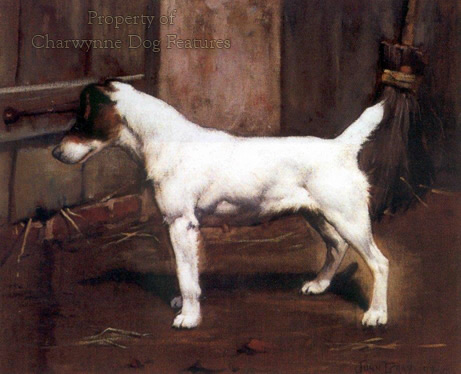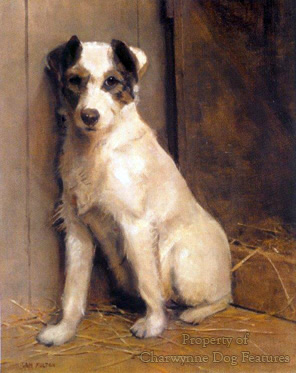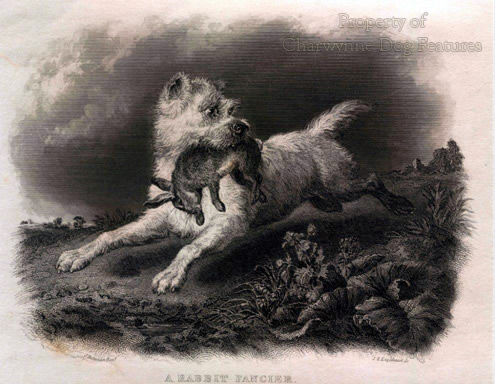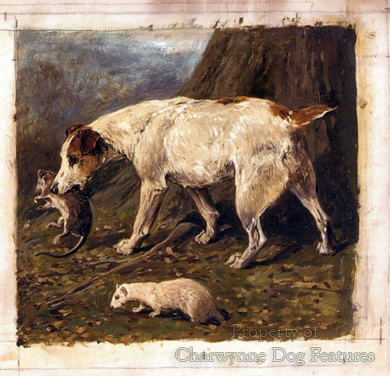792 A Russell of Spring
A Russell Of Spring
by David Hancock
 What do breeders of Jack Russells want from their dogs? Gifted ratters or cat-loving couch dwellers? 'Ornery critters or ornamental lounge lizards? Should they be basset-legged or ramrod-straight at the front? Should they move with power or a 'skip and a jump'? Are we seeking terriers that are 'crackers' or Quakers! Do we prize their sparkiness or dread their outbursts of spikiness? Does the size, shape, physical condition and temperament of Russells matter? Old terrier experts are always worth heeding. They rated their dogs on performance not their prettiness. That is the major difference between the terriers of the old timers and those of today. Russell himself expected quite a lot from his terriers but are we breeding them to his template?
What do breeders of Jack Russells want from their dogs? Gifted ratters or cat-loving couch dwellers? 'Ornery critters or ornamental lounge lizards? Should they be basset-legged or ramrod-straight at the front? Should they move with power or a 'skip and a jump'? Are we seeking terriers that are 'crackers' or Quakers! Do we prize their sparkiness or dread their outbursts of spikiness? Does the size, shape, physical condition and temperament of Russells matter? Old terrier experts are always worth heeding. They rated their dogs on performance not their prettiness. That is the major difference between the terriers of the old timers and those of today. Russell himself expected quite a lot from his terriers but are we breeding them to his template?
The Rev John Russell's own description of his ideal terrier as manifested in his renowned 'Trump' is worth quoting: "Her colour was white, with just a patch of dark tan over each ear and a similar dot not larger than a penny piece over the root of her tail. The coat, which was thick, close and a trifle wavy, was well calculated to protect the body from the wet and cold. The legs were straight, short and thick, and the feet perfect, while the size was equal to that of a full-grown vixen fox, that is to say, her weight was about twelve pounds. Her whole appearance gave indications of courage, endurance and hardihood." Those are the three key qualities in any working dog.
It is interesting to compare the great man's words with those of the Breed Standard first proposed by the Kennel Club-sanctioned Parson Russell Terrier Club. This early official club word picture stated: "Coat - rough, a trifle wiry or smooth. Dense with belly and undersides not bare...Forelegs - strong and straight with joints in correct alignment. Elbows hanging perpendicular to the body, working free of the sides." (I'm not sure I want to be seen with a dog answering to that description!) There was no indication of what the dog's general appearance should be like; I think I'll stay with the vicar! Any pedigree Parson Russell dog which is less than 14" at the shoulder does not meet the requirements of the official KC breed standard. This means that the best working Jack Russell in the whole country could not win in the KC show ring entirely on grounds of size. Is that the best way to judge sporting terriers? 
After one 2011 Kennel Club-approved show for the Parson Russell Terrier, that is the KC-registered version of the Jack Russell Terrier, the judge’s critique included these words: “It is just short of two years since I last judged this breed at the other end of the country, I found it interesting to see how some dogs that I judged then had changed with maturity over that time…I found type quite varied and it is disappointing to see that the breed is losing some breed specific points which all add up to make the Parson Russell Terrier…This is a dog of moderation not exaggeration…” This judge was concerned about over and under-angulation in the hindquarters, too narrow a skull, too high a set of tail and a strong slightly-arched loin giving way to a straight topline. There is nothing new in such concerns about loss of both true type and the working anatomy in such a terrier.
Just over a century ago, Alys Serrell, a famous breeder of smooth Fox Terriers, was writing in her With Hound and Terrier in the Field – Hunting Reminiscences of 1904: “There are fox-terriers with heads so long and narrow as to leave no room for brains; so high on the leg they cannot go into a fox or badger earth without being crippled with cramp; or again so flat-sided as to have no stamina.” Even earlier, in the 1870s, the Rev Thomas Pearce, alias ‘Idstone’, was writing: “I have seen charming terriers, bred by Mr Russell…I have one at the present time which has run with hounds three seasons…He is rather leggy; but perhaps there is not a great objection, considering that he had run with hounds. He is rather narrow in the chest, which, as I believe, gives speed to dog or horse. At any rate, I never saw a fast animal with a wide chest.” He didn’t relate these physical attributes to the terrier’s needs underground, where the working terrier’s ability to function is tested more realistically.
In France, the Societe Centrale Canine and the Reunion des Amateurs de Fox Terriers have instituted the Coupe de France de Broussaillage - flushing game above ground. Smooth Fox Terriers there are recognized not just below ground, but for their aptitude for hunting above ground, flushing out wild pig from thick undergrowth and their persistence and boldness in the drive. German Hunt Terriers, Jack Russells and Welsh Terriers are used, as well as the Fox. Points are awarded for performance during the search (15), flushing and voice (20), drive and pursuit (10) and reaction to gunfire (5). Judges can multiply the scores according to the dog’s overall showing, so that a total of say 40 could be increased by doubling or even tripling the score to 80 or 120. Grades are awarded for 125-150 points (excellent), 100-125 (tres bon) and 75-100 (bon), with 50-75 earning an honourable mention. How good it would be if such terrier working tests were to be introduced here, if only to reveal the braggers! Is a Jack Russell without some working instinct and a working build really a Russell?
"First of all make certain that you have the sort of terrier whose build will enable him to do his job effectively and with ease to himself." That quaintly-worded but still telling advice was offered seventy years ago by the field sports enthusiast and working terrier devotee, Major GB Ollivant. But what build does enable the earth-dog to do his job not only well but more easily? Mr OT Price, that much-loved old terrier-man, who sustained his own type of terrier from 1896 to the 1950s, opted for a dog "Twelve inches in height, about three and a half in breadth and weighing about twelve pounds." "I like a narrow eel-like terrier" he used to counsel. Certainly his favourite dogs 'Tartar' and 'Worry' and his little bitch 'Twinkle', famed over many counties, were on these lines. Are we still seeking vermin-killers or Vogue-models?
Geoffrey Sparrow, in his classic 'The Terrier's Vocation', goes for a dog "...weighing from twelve to sixteen pounds, with a strong jaw - not snipey like the show breeds -- a good back, neck and shoulders, and fairly long legs. The length doesn't matter. They can be folded up while bad shoulders cannot." He would not have liked the Fox Terriers in contemporary Kennel Club show rings, with their upright shoulders and ant-eater muzzles. If they could actually get underground, they are unlikely to re-emerge! Is there not just too much show-ring, TV-at-Crufts style of thinking over the breeding of Russells nowadays? Doesn't a working build really make a terrier?
But I'll go back to Major Ollivant for a most interesting description of the physique of his terriers: "The conformation I have always found the best for a Working or Hunt Terrier is that which approaches the nearest in build to the short-backed, short-legged hunter...like the short-legged hunter he must have long, well laid back, sloping shoulders, a short back and big long galloping quarters. This conformation will make him stand over a lot of ground, in spite of the fact that his back is short and not long." As he didn't specify proportions, it is arguable what he really meant by the word 'short' in connection with backs. Most wild creatures which live underground have been shaped by nature to have relatively long backs. Why breed a hunter when you really seek a mole!
Dan Russell, in his admirable 'Working Terriers', states "Fourteen pounds should be the weight to seek for...Length of leg does not matter a great deal. A long-legged dog can get down a surprisingly small hole if he is narrow chested...The dog to refuse instantly is the one with loaded shoulders or turned-out elbows or a wide cobby chest." In the same vein, William Baker, one of the breeders who developed the Sealyham, has put on record: "In my opinion, no Terrier for underground work should be coarse in his shoulders, but my experience teaches me that nature decrees that a certain width of chest is always there in the gamest of them. The Sealyham of today is verging on a fancier's craze - straightness, length of head, great bone and cloddiness. If these are carried to excess, goodbye to him as a working Terrier." Prophetic words!
If you then spend time studying this breed in the ring, what do you find? I see them, almost invariably, with short upper arms and upright shoulders which limit their reach and give them a fast, chopping, stilted, abbreviated front action with nothing free about it. And they win! And they win at Crufts! The profusion of coat in some of them gives the illusion of their flowing over the ground - but then so too do millipedes. The extent of a dog's front stride is controlled by the length of its upper arm and the angulation or slope of its shoulders. The too-fast, short-reaching, chopping action of so many small terriers in the ring has almost become the norm. A good judge would notice that there is nothing free about such an action; the dog has to take two or three steps when one should do. Not surprisingly this affects hind action too. Russells may not be over-burdened with coat but their movement is often bizarre.
The late Tom Horner, who knew a thing or two about terrier movement, has written on this subject: "If the upper arm is short and/or steep, the angle between it and the shoulder blade will be much greater - more open than the desired 90 degrees - with the result that the elbow will be brought forward on the chest and the possible length of stride of the foreleg will be reduced. If shoulders are also steep the angle will be greater still and the stride even shorter." Small terriers with a shortened front stride are now almost the uniform exhibit in our show rings. It is extremely tiresome when this draws admiration from ignorant TV commentators at Crufts, who describe them as "simply flowing over the ground", perhaps because they simply have to take too many steps from a combination of short upper arms and upright shoulders!
Arthur Blake Heinemann, once a KC terrier judge, writing on Hunt Terriers in The Field, October, 1912, stated: “Forbidden fruit is always sweetest, and breeders of show terriers are never tired of dinning into one’s ears that their dogs are workers as well, and bred on the right lines for make and shape, but they lose sight of the fact that while they have been breeding them for straightness, they have acquired a giraffe-like length of leg, and while breeding them for appearance and show-points they have lost all their individuality, intelligence and stamina.” In an article in Field Sports magazine of June 1952, veteran terrier-man RR Stopford wrote: “The weight for all types of work should not be more than sixteen pounds, and preferably about fourteen. Colour, looks and length of coat are personal considerations, but the more white there is the better, because a conspicuous colour has its advantages when shooting in thick cover. Another controversial point is the length of muzzle. A long nose is useful for ratting, but takes heavier punishment underground; moreover, it is but rarely accompanied by a strong wide jaw, so that, on the whole, we may say the shorter the better.” He would not like the head of today’s Fox Terrier, but it is of interest to see his high priority for the colour of his dogs’ coats. Does the colour of a Russell matter? Do they have to be mainly white? Once, character was all!
CGE Wimhurst, writing in his The Book of Terriers, Muller, 1968, stated: “These old working terriers were tough and strong. They had to be because their daily life consisted of facing cornered animals which they had to kill or bolt. The fighting underground was savage and the terrier was expected to succeed or die – and many of them did – either through bites or by being trapped under the earth. Courage or ‘gameness’ was the quality most prized by the terrier breeders and cowardly dogs were very rare indeed because a terrier showing the slightest trace of fear was quickly destroyed and never used for breeding. The old types were also swift and some were known to have covered over six miles in thirty minutes – a very good time over rough country by a comparatively short-legged animal.” How do we test today's dogs?
Ugly, feisty, little varmint or cuddly, cute, canine fashion-model? Couch potato or crouching tiger? Scarred canine miner or handsome 'reduced hound'? What should a sporting terrier look like? Does its anatomy truly matter? Is its spirit more important? 
In Field Sports magazine in 1949, in an article entitled The Hunt Terrier Man and His Dogs, old terrier-man Fred F Wood wrote of his kind: “There is also another attendant to the pack, the terrier man…then look at his little companions, maybe a couple or a couple and a half of terriers, not much to look at perhaps, the show terrier man might call them ugly little mongrels, but there is no mongrel about them, many of their pedigrees have been as carefully kept as those of the hounds, not for their appearance, but for their qualities. They have to be constructed of bone, wire and whip cord, and have coats that will keep out cold and wet and then on top of that be brave as lions, if they are to do the work they are called upon to do…so think of those little terriers…they will stay and fight their fox until he bolts or they are dug out, that requires pluck.” It was fear of their terriers losing their working anatomy, and especially their ‘pluck’, which steered working terrier enthusiasts away from the show ring. Are the Parson Russell Club members following an undesired direction?
At a Scottish KC Championship show a year or so ago, the judge recorded: "When recognition of the PJRT took place I was under the impression that we were going to preserve the look of this old type of working terrier, it now seems that some breeders with no knowledge of, or regard for, the traditional type are determined, with the help of judges with no breed type experience, to change completely the character and look of the breed." That, in comparatively few words, sums up very aptly what happens to terrier breeds in the KC show rings. When judging the build of a working terrier, let's be guided by the wise words of our Major Ollivant: "A terrier that has to work underground must have his heart in the right place; then if his body permits him to do so, he will get there like the good sportsman he is." The only reason why we have working terriers to breed from nowadays is that countrymen who were real terrier-men kept their heads over many years and ignored the financial allure and false glamour of the KC show rings. I want a 'Russell of Spring'!